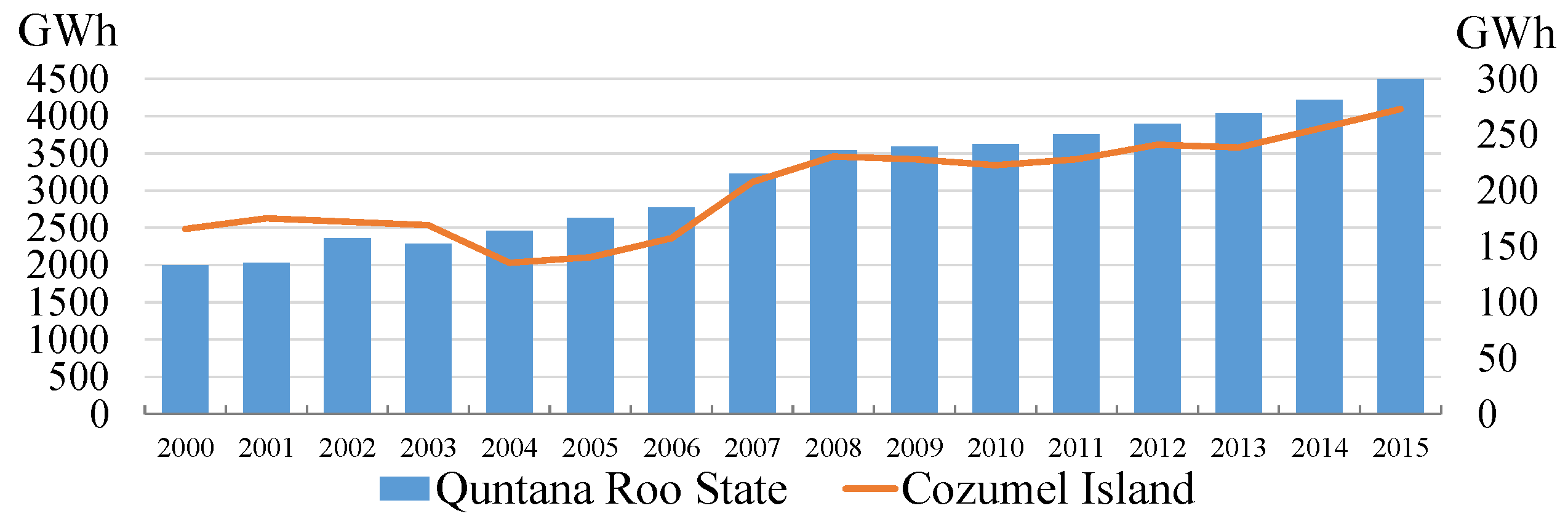PV, Wind and Storage Integration on Small Islands for the Fulfilment of the 50-50 Renewable Electricity Generation Target
Abstract
:1. Introduction
2. Methodology Plan for the Integration of Renewable Electricity Generation on Small Islands
Phase I
- Targets are set on the basis of national, regional or local energy planning objectives.
- Development of the analysis of the island’s electrical system data.
- The results from the electrical system data analysis are used to build the prospective scenarios.
Phase II
- Local resource potential is determined according to the natural resource potential analysis.
- The renewable energy technologies are selected and proposed.
- Selection of the proposed hybrid energy systems.
- Integration of the hybrid system into the island’s electric grid is simulated through a deterministic methodology with a time-series simulation software tool.
Phase III
- The results of the electrical system’s operation obtained from the optimization and simulation software tool are analysed through a decision support system.
- DSV and linear regression models are used to evaluate and validate systems that fulfil the targets and can be deployed on the island.
- The best resultant system is chosen to be installed.
3. Study Case: Cozumel Island, Mexico
3.1. Mexico Energy and Electric Sector Status
3.2. Renewable Energy in Mexico
3.3. Electricity in the Peninsular Area
3.4. Cozumel Island
3.4.1. Setting the Long-Term Electric System Target
3.4.2. Analysis of the Current Electric System
3.4.3. RE Potential on Cozumel Island
3.4.4. Renewable Energy Sources Selection
3.4.5. RETs System Proposals and Its Combination with Diesel and Flow Batteries
4. Results
4.1. Previous Essential Information
4.2. Technical Results
4.3. Economic Results
4.4. System Selection
4.5. Selected System Analysis
4.6. Emission Factor Reduction Results
5. Conclusions and Discussion
Acknowledgments
Author Contributions
Conflicts of Interest
References
- Romano, A.A.; Scandurra, G.; Carfora, A.; Pansini, R.V. Assessing the determinants of SIDS’ pattern toward sustainability: A statistical analysis. Energy Policy 2016, 98, 688–699. [Google Scholar] [CrossRef]
- Bertin, A.; Frangi, J. Contribution to the study of the wind and solar radiation over Guadeloupe. Energy Convers. Manag. 2013, 75, 593–602. [Google Scholar] [CrossRef]
- Meschede, H.; Holzapfel, P.; Kadelbach, F.; Hesselbach, J. Classification of global island regarding the opportunity of using RES. Appl. Energy 2016, 175, 251–258. [Google Scholar] [CrossRef]
- Blechinger, P.; Cader, C.; Bertheau, P.; Huyskens, H.; Seguin, R.; Breyer, C. Global analysis of the techno-economic potential of renewable energy hybrid systems on small islands. Energy Policy 2016, 98, 674–687. [Google Scholar] [CrossRef]
- Blechinger, P.; Seguin, R.; Cader, C.; Bertheau, P.; Breyer, C. Assessment of the Global Potential for Renewable Energy Storage Systems on Small Islands. Energy Procedia 2014, 46, 294–300. [Google Scholar] [CrossRef]
- Kaldellis, J.; Gkikaki, A.; Kaldelli, E.; Kapsali, M. Investigating the energy autonomy of very small non-interconnected islands. Energy Sustain. Dev. 2012, 16, 476–485. [Google Scholar] [CrossRef]
- Patlitzianas, K.D.; Christos, K. Effective financing for provision of renewable electricity and water supply on islands. Energy Sustain. Dev. 2012, 16, 120–124. [Google Scholar] [CrossRef]
- Díaz-González, F.; Sumper, A.; Gomis-Bellmunt, O.; Villafáfila-Robles, R. A review of energy storage technologies for wind power applications. Renew. Sustain. Energy Rev. 2012, 16, 2154–2171. [Google Scholar] [CrossRef]
- Portero, U.; Velázquez, S.; Carta, J.A. Sizing of a wind-hydro system using a reversible hydraulic facility with seawater. A case study in the Canary Islands. Energy Convers. Manag. 2015, 106, 1251–1263. [Google Scholar] [CrossRef]
- Chen, C.L.; Chen, H.C.; Lee, J.Y. Application of a generic superstructure-based formulation to the design of wind-pumped-storage hybrid systems on remote islands. Energy Convers. Manag. 2016, 111, 339–351. [Google Scholar] [CrossRef]
- Kuang, Y.; Zhang, Y.; Zhou, B.; Li, C.; Cao, Y.; Li, L.; Zeng, L. A review of renewable energy utilization in islands. Renew. Sustain. Energy Rev. 2016, 59, 504–513. [Google Scholar] [CrossRef]
- Mendoza-Vizcaino, J.; Sumper, A.; Sudria-Andreu, A.; Ramirez, J. Renewable technologies for generation systems in islands and their application to Cozumel Island, Mexico. Renew. Sustain. Energy Rev. 2016, 64, 348–361. [Google Scholar] [CrossRef]
- International Energy Agency (IEA). Energy Technology Perspectives 2014; Technical Report; International Energy Agency: Paris, France, 2014. [Google Scholar]
- International Energy Agency (IEA). Energy Technology Perspectives 2015 (Executive Summary); Technical Report; International Energy Agency: Paris, France, 2015. [Google Scholar]
- Paris 2015: Tracking country climate pledges. Carbon Brief, 16 September 2015.
- United Nations Framework Convention on Climate Change (UNFCCC). Paris Agreement—Status of Ratification; UNFCCC: Paris, France, 2015. [Google Scholar]
- Presidency of the Republic of Kazakhstan. CONCEPT for Transition of the Republic of Kazakhstan to Green Economy; Technical Report; Presidency of the Republic of Kazakhstan: Astana, Kazakhstan, 2013.
- Climate Action Programme. United Arab Emirates Sets Sights on 50% Clean Energy Target—Climate Action Programme; Climate Action Programme: London, UK, 2017. [Google Scholar]
- Ministerio de Pesca y Medio Ambiente (MPMA). Contribuciones Previstas Determinadas a Nivel Nacional; Technical Report; MPMA: Malabo, Equatorial Guinea, 2015.
- International Energy Agency (IEA). Island Energy—Status and Perspectives. EXECUTIVE SUMMARY; Technical Report; International Energy Agency: Tokyo, Japan, 2015. [Google Scholar]
- Fripp, M. Switch: A Planning Tool for Power Systems with Large Shares of Intermittent Renewable Energy. Environ. Sci. Technol. 2012, 46, 6371–6378. [Google Scholar] [CrossRef] [PubMed]
- Nelson, J.; Johnston, J.; Mileva, A.; Fripp, M.; Hoffman, I.; Petros-Good, A.; Blanco, C.; Kammen, D.M. High-resolution modeling of the western North American power system demonstrates low-cost and low-carbon futures. Energy Policy 2012, 43, 436–447. [Google Scholar] [CrossRef]
- HOMER Energy LLC. HOMER PRO Ver. 3.7.4; HOMER Energy LLC: Boulder, CO, USA, 2016. [Google Scholar]
- Clark, R. A Predictive Optimal Dispatch and Optimal Sizing Method for a System Declaration of Authorship. Master’s Thesis, University of the Witwatersrand, Johannesburg, South Africa, 2014. [Google Scholar]
- HOMER Energy LLC. HOMER Microgrid White Papers; HOMER Energy LLC: Boulder, CO, USA, 2017. [Google Scholar]
- HOMER Energy LLC. HOMER Energy; HOMER Energy LLC: Boulder, CO, USA, 2017. [Google Scholar]
- Lambert, T.; Gilman, P.; Lilienthal, P. MICROPOWER SYSTEM MODELING WITH HOMER. In Integration of Alternative Sources of Energy, 1st ed.; Farret, F.A., Simões, M.G., Eds.; Wiley-IEEE: Hoboken, NJ, USA, 2006; Chapter 15; p. 504. [Google Scholar]
- Watson, D.; Binnie, Y.; Duncan, K.; Dorville, J.F. Photurgen: The open source software for the analysis and design of hybrid solar wind energy systems in the Caribbean region: A brief introduction to its development policy. Energy Rep. 2017, 3, 61–69. [Google Scholar] [CrossRef]
- Watson, D.; Binnie, Y.; Duncan, K.; Dorville, J.-F. Photurgen 1.0. |The Open-Source Renewable Energy Software, University of the West Indies: Kingston, Jamaica, 2016.
- Gils, H.C.; Simon, S. Carbon neutral archipelago—100% renewable energy supply for the Canary Islands. Appl. Energy 2017, 188, 342–355. [Google Scholar] [CrossRef]
- Quesada, P.V.; Isidoro, M.A.; López, M.L.A. Curso y Ejercicios de Estadística, 3rd ed.; Alhambra Longman, S.A.: Madrid, Spain, 1982; p. 433. [Google Scholar]
- Hong, G.W.; Abe, N.; Baclay, M.; Arciaga, L. Assessing users’ performance to sustain off-grid renewable energy systems: The capacity and willingness approach. Energy Sustain. Dev. 2015, 28, 102–114. [Google Scholar] [CrossRef]
- Prasad, R.D.; Raturi, A. Grid electricity for Fiji islands: Future supply options and assessment of demand trends. Energy 2017, 119, 860–871. [Google Scholar] [CrossRef]
- Yue, C.D.; Chen, C.S.; Lee, Y.C. Integration of optimal combinations of renewable energy sources into the energy supply of Wang—An Island. Renew. Energy 2016, 86, 930–942. [Google Scholar] [CrossRef]
- International Energy Agency (IEA). Key World Energy Statistics; Technical Report; International Energy Agency: Paris, France, 2016. [Google Scholar]
- Organization for Economic Cooperation and Development. Primary Energy Supply (Indicator); Organization for Economic Cooperation and Development: Paris, France, 2016. [Google Scholar]
- Secretaría de Energía. Sistema de Información de Energía (SIE); Secretaría de Energía: Mexico City, Mexico, 2016.
- Iñaki, A.; Iñigo, C.P.; Rosa, L.; Gorka, B.; Bermejo, R. The energy requirements of a developed world. Energy Sustain. Dev. 2016, 33, 1–13. [Google Scholar]
- Secretaría de Energía. Development Program for the National Electric System (PRODESEN) 2016–2030 PART II; Technical Report; Secretaría de Energía: Mexico City, Mexico, 2016.
- Secretaría de Energía. Prospectiva del Sector Eléctrico (PSE) 2015–2029; Technical Report; Secretaría de Energía: Mexico City, Mexico, 2015.
- Presidencia de la República Mexicana. Decreto Expedición de la Ley de la Industria Electrica (LIE) y la Ley de Energía Geortermia (LEG); Technical Report; Presidencia de la República Mexicana: Mexico City, Mexico, 2014.
- Secretaría de Energía. Prospectiva de Energías Renovables (PER) 2015–2029; Technical Report; Secretaría de Energía: Mexico City, Mexico, 2015.
- International Energy Agency (IEA). Mexico Energy Outlook 2016; Technical Report; International Energy Agency: Paris, France, 2016. [Google Scholar]
- Presidencia de la República Mexicana. Ley de Transición Energética (LTE); Technical Report; Presidencia de la Republica: Mexico City, Mexico, 2015.
- Presidencia de la República Mexicana. Ley General De Cambio Climático (LGCC); Technical Report; Presidencia de la República Mexicana: Mexico City, Mexico, 2012.
- Secretaría de Energía. Estrategia de Transición para Promover el Uso de Tecnologías y Combustibles más Limpios 2016; Technical Report; Secretaría de Energía: Mexico City, Mexico, 2016.
- Secretaría de Energía. Programa Especial para el Aprovechamiento de Energías Renovables (PEAER) 2014; Technical Report; Secretaría de Energía: Mexico City, Mexico, 2014.
- Secretaría de Medio Ambiente y Recursos Naturales. Estrategia Nacional de Cambio Climático (ENCC); Technical Report; Secretaría de Medio Ambiente y Recursos Naturales: Mexico City, Mexico, 2013.
- Secretaría de Energía. Programa Sectorial de Energía (PROSENER) 2013–2018; Technical Report; Secretaría de Energía: Mexico City, Mexico, 2013.
- Secretaría de Energía. Estrategia Nacional de Transición Energética y el Aprovechamiento Sustentable de la Energía (ENTEASE) 2014; Technical Report; Secretaría de Energía: Mexico City, Mexico, 2014.
- Secretaría de Energía. Estrategia Nacional de Energía (ENE) 2014–2028; Technical Report; Secretaría de Energía: Mexico City, Mexico, 2014.
- Secretaría de Energía. Programa Especial de Cambio Climatico (PECC) 2014; Technical Report; Secretaría de Energía: Mexico City, Mexico, 2014.
- Secretaría de Energía. Programa Nacional Para el Aprovechamiento Sustentable de la Energía (PRONASE) 2014; Technical Report; Secretaría de Energía: Mexico City, Mexico, 2014.
- Secretaría de Energía. Development Program for the National Electric System (PRODESEN) 2016–2030 PART I; Technical Report, Secretaría de Energía: Mexico City, Mexico, 2016. [Google Scholar]
- Instituto Nacional de Estadística y Geografía (INEGI). Cuentame (INEGI); INEGI: Mexico City, Mexico, 2015.
- Wiken, E.; Jiménez-Nava, F.; Griffith, G. North American Terrestrial Ecoregions—Level III; Technical Report; Commission for Environmental Cooperation: Montreal, QC, Canada, 2011. [Google Scholar]
- Dornan, M.; Shah, K.U. Energy policy, aid, and the development of renewable energy resources in Small Island Developing States. Energy Policy 2016, 98, 759–767. [Google Scholar] [CrossRef]
- Timilsina, G.R.; Shah, K.U. Filling the gaps: Policy supports and interventions for scaling up renewable energy development in Small Island Developing States. Energy Policy 2016, 98, 653–662. [Google Scholar] [CrossRef]
- Comisión Federal de Electricidad (CFE). Economic Dispatch (Despacho económico); CFE: Mexico City, Mexico, 2015.
- Instituto Nacional de Estadística y Geografía (INEGI). BIINEGI; INEGI: Mexico City, Mexico, 2015.
- Secretaría de Energía. National Inventory of Renewable Energy (INERE); Secretaría de Energía: Mexico City, Mexico, 2016.
- Comisión Nacional para el Conocimiento y Uso de la Biodiversidad. INE, (28/10/2014). ‘Ríos. Conjunto de Datos Vectoriales del Instituto Nacional Electoral.’; Comisión Nacional para el Conocimiento y Uso de la Biodiversidad: Mexico City, Mexico, 2015.
- Instituto Nacional de Estadística y Geografía (INEGI). Anuario Estadístico y Geográfico de Quintana Roo 2015; Technical Report; Instituto Nacional de Estadística y Geografía: Mexico City, Mexico, 2015.
- Instituto Nacional de Estadística y Geografía (INEGI). Atlas Agropecuario: Quintana Roo 1996. Datos Ejidales; Technical Report; Instituto Nacional de Estadística y Geografía: Mexico City, Mexico, 1996.
- Villarrubia López, M. Influencia de obstáculos. In Ingeniería de la Energía Eólica, 1st ed.; Marcombo, S., Ed.; Engineering Faculty, Barcelona University: Barcelona, Spain, 2012; Chapter 4; p. 283. [Google Scholar]
- Cabrera-Tobar, A.; Bullich-Massagué, E.; Aragüés-Peñalba, M.; Gomis-Bellmunt, O. Review of advanced grid requirements for the integration of large scale photovoltaic power plants in the transmission system. Renew. Sustain. Energy Rev. 2016, 62, 971–987. [Google Scholar] [CrossRef]
- Katsigiannis, Y.A.; Georgilakis, P.S.; Karapidakis, E.S. Genetic Algorithm Solution to Optimal Sizing Problem of Small Autonomous Hybrid Power Systems. In Artificial Intelligence: Theories, Models and Applications. LNCS; Konstantopoulos, S., Perantonis, S., Karkaletsis, V., Spyropoulos, C.D., Vouros, G., Eds.; Springer: Berlin/Heidelberg, Germany; Athens, Greece, 2010; Volume 6040, pp. 327–332. [Google Scholar]
- Goldwing USA Inc. PMDD Wind Turbine; Goldwing USA Inc.: Chicago, IL, USA, 2016. [Google Scholar]
- W2E Wind to Energy GmbH. Harvester 3.0 MW; W2E Wind to Energy GmbH: Rostock, Germany, 2016. [Google Scholar]
- Sany Heavy Energy Machinery Co. Ltd. Poem of the Wind; Sany Heavy Energy Machinery Co. Ltd.: Beijing, China, 2016. [Google Scholar]
- EWT Americas Inc. Power Curve DW54; EWT Americas Inc.: Amersfoort, Germany, 2016. [Google Scholar]
- ENERCON GmbH. ENERCON Product Overview; ENERCON GmbH: Aurich, Germany, 2016. [Google Scholar]
- EnSync Inc. Agile Flow Battery; EnSync Inc.: Menomonee Falls, WI, USA, 2016. [Google Scholar]
- Manwell, J.F.; McGowan, J.G. Lead acid battery storage model for hybrid energy systems. Sol. Energy 1993, 50, 399–405. [Google Scholar] [CrossRef]
- EnSync Inc. EnerSection® Power & Energy Control; EnSync Inc.: Menomonee Falls, WI, USA, 2016. [Google Scholar]
- International Energy Agency (IEA). Next Generation Wind and Solar Power; Technical Report; International Energy Agency: Paris, France, 2016. [Google Scholar]
- International Energy Agency (IEA); Organization for Economic Cooperation and Development (OECD); Nuclear Energy Agency (NEA). Projected Costs of Generating Electricity, 2015 ed.; Technical Report; International Energy Agency: Paris, France, 2015. [Google Scholar]
- Huff, G.; Currier, A.B.; Kaun, B.C.; Rastler, D.M.; Chen, S.B.; Bradshaw, D.T.; Gauntlett, W.D. DOE/EPRI 2013 Electricity Storage Handbook in Collaboration with NRECA; Report SAND2013; Sandia National Laboratories: Albuquerque, NM, USA, 2013; p. 340. [Google Scholar]
- Wiser, R.; Bolinger, M. 2015 Wind Technologies Market Report; Technical Report, U.S. Department of Energy, Office of Scientific and Technical Information: Oak Ridge, TN, USA, 2016. [Google Scholar]
- World Bank. World Bank Data; World Bank: Washington, DC, USA, 2016. [Google Scholar]
- Figueroa-Espinoza, B.; Salles, P.; Zavala-Hidalgo, J. On the wind power potential in the northwest of the Yucatan Peninsula in Mexico. Atmósfera 2014, 27, 77–89. [Google Scholar] [CrossRef]
- Diario Oficial de la Federación (DOF). Exchange Rate Indicators; DOF: Mexico City, Mexico, 2016.
- Centro Nacional de Control de Energía (CENACE). Resultados Preliminares de la 2a Subasta Eléctrica de Largo Plazo; CENACE: Mexico City, Mexico, 2016.
- Ramirez, M.G.; Román, K.E.Á. Ciclones tropicales que se formaron al Este de las Antillas menores e impactaron los estados costeros del litoral oriental de México de 1900 al 2003. Revista Geográfica 2005, 137, 57–80. [Google Scholar]
- Division, H.R. Hurrican Data By Year and Storm; National Oceanic and Atmospheric Administration (NOAA): Virginia Key, FL, USA, 2016.
- Schott, T.; Landsea, C.; Hafele, G.; Lorens, J.; Thurm, H.; Ward, B.; Willis, M.; Zaleski, W. The Saffir-Simpson Hurricane Wind Scale; National Hurricane Center, National Oceanic and Atmospheric Administration (NOAA): Virginia Key, FL, USA, 2012; pp. 1–4.
- Minitab Inc. Minitab® Statistical Software, Minitab Inc.: State College, PA, USA, 2013.
- Vidal-Amaro, J.J.; Østergaard, P.A.; Sheinbaum-Pardo, C. Optimal energy mix for transitioning from fossil fuels to renewable energy sources—The case of the Mexican electricity system. Appl. Energy 2015, 150, 80–96. [Google Scholar] [CrossRef]
- Østergaard, P.A. Reviewing EnergyPLAN simulations and performance indicator applications in EnergyPLAN simulations. Appl. Energy 2015, 154, 921–933. [Google Scholar] [CrossRef]
- Secretaría de Medio Ambiente y Recursos Naturales. Factor de Emisión Eléctrico 2014 (Programa GEI México); Secretaría de Medio Ambiente y Recursos Naturales: Mexico City, Mexico, 2014.
- Joint Research Centre of the European Commission. Energy Technology Reference Indicator Projections for 2010–2050; Technical Report; Institute for Energy and Transport of the Joint Research Centre of the European Commission: Petten, The Netherlands, 2014. [Google Scholar]
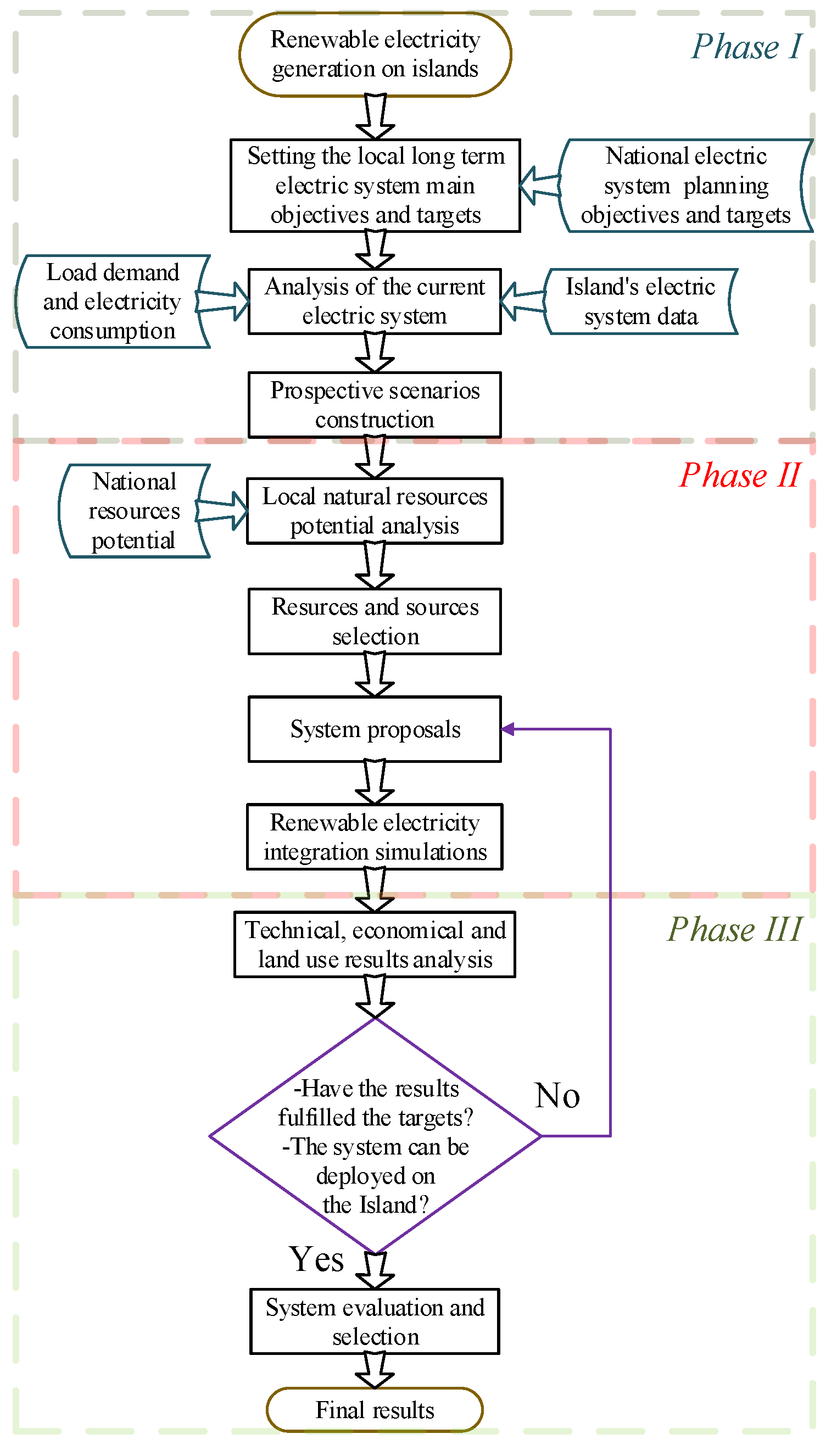

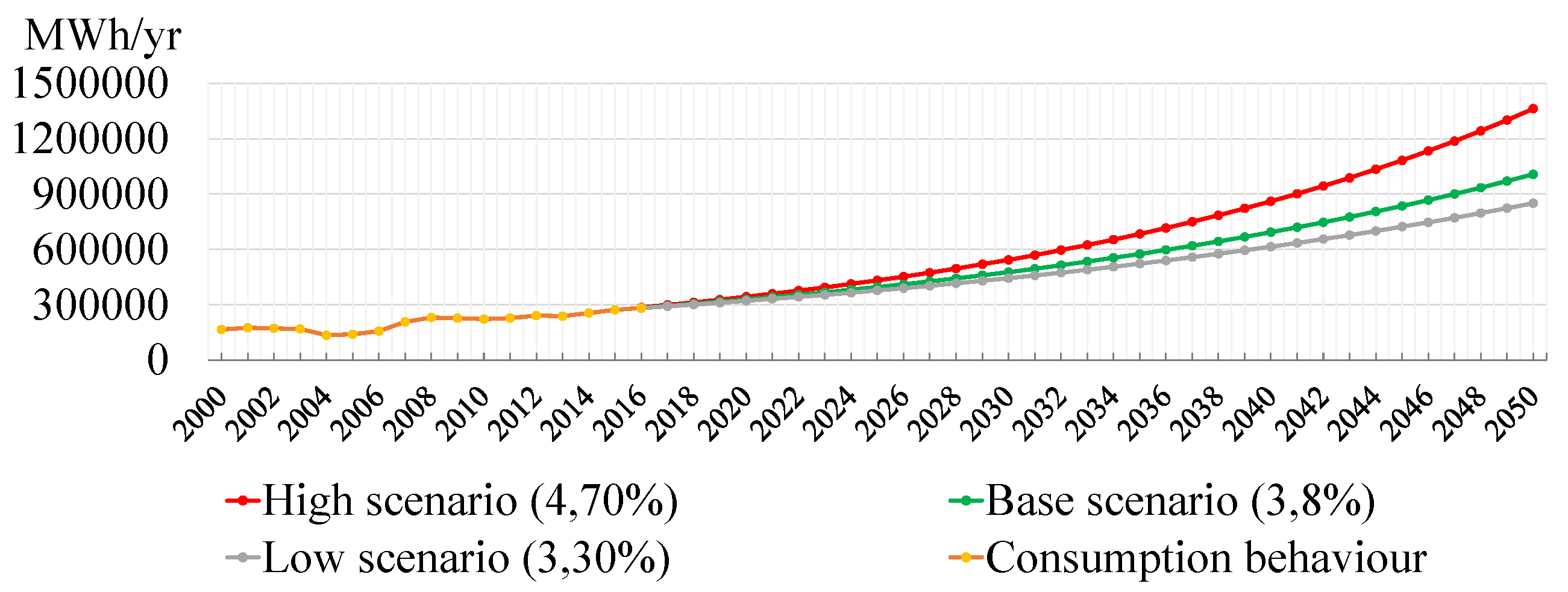

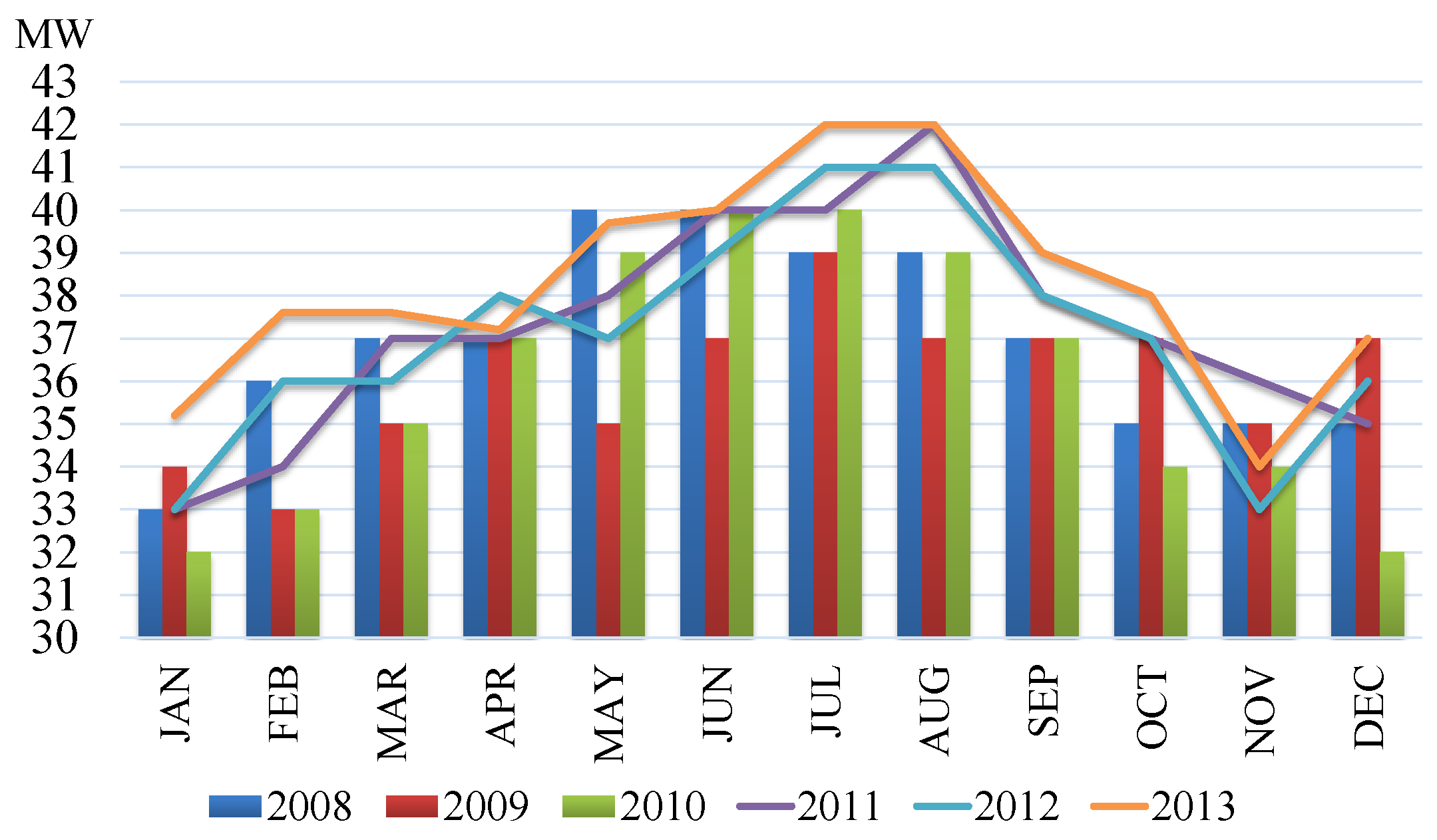


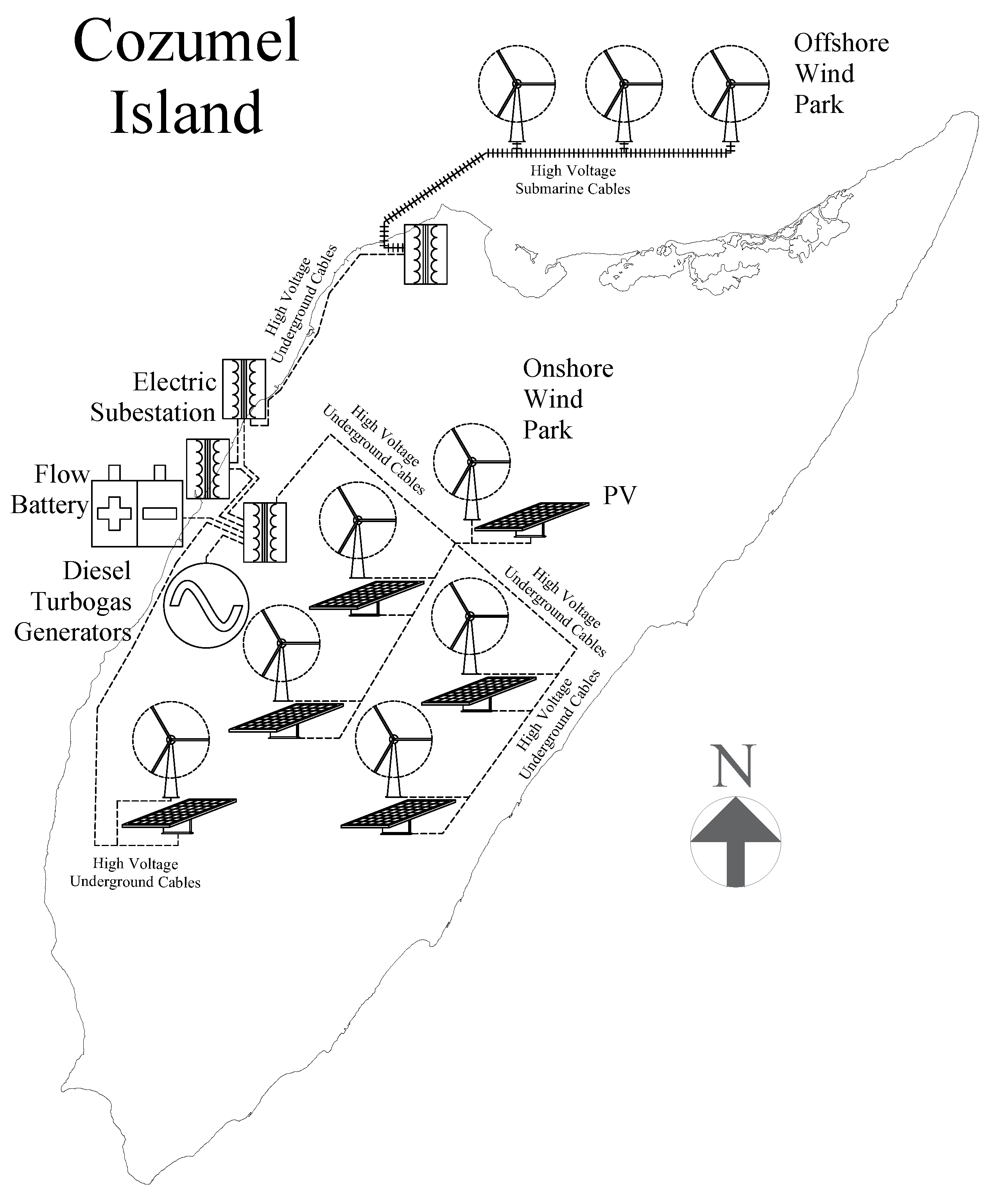





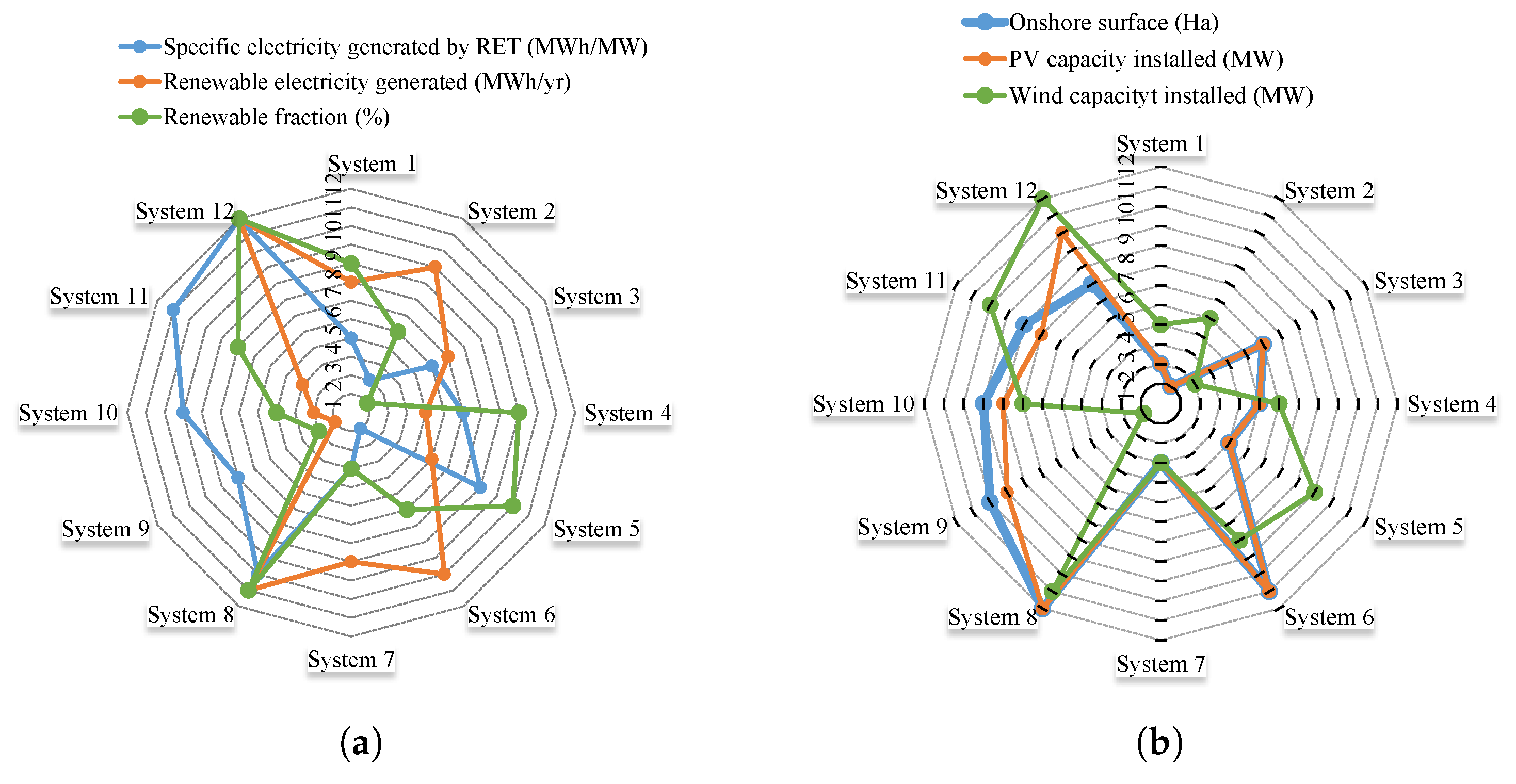




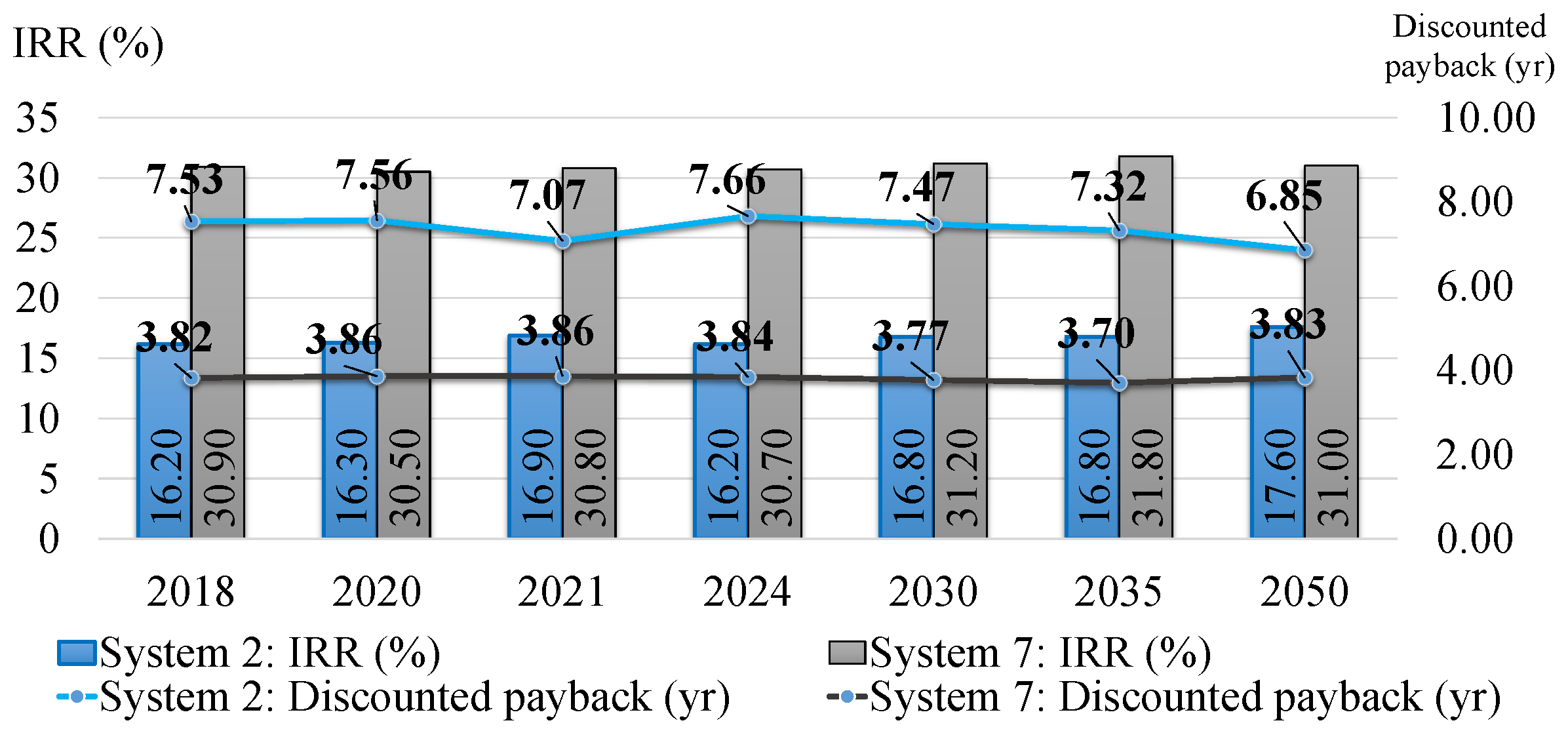
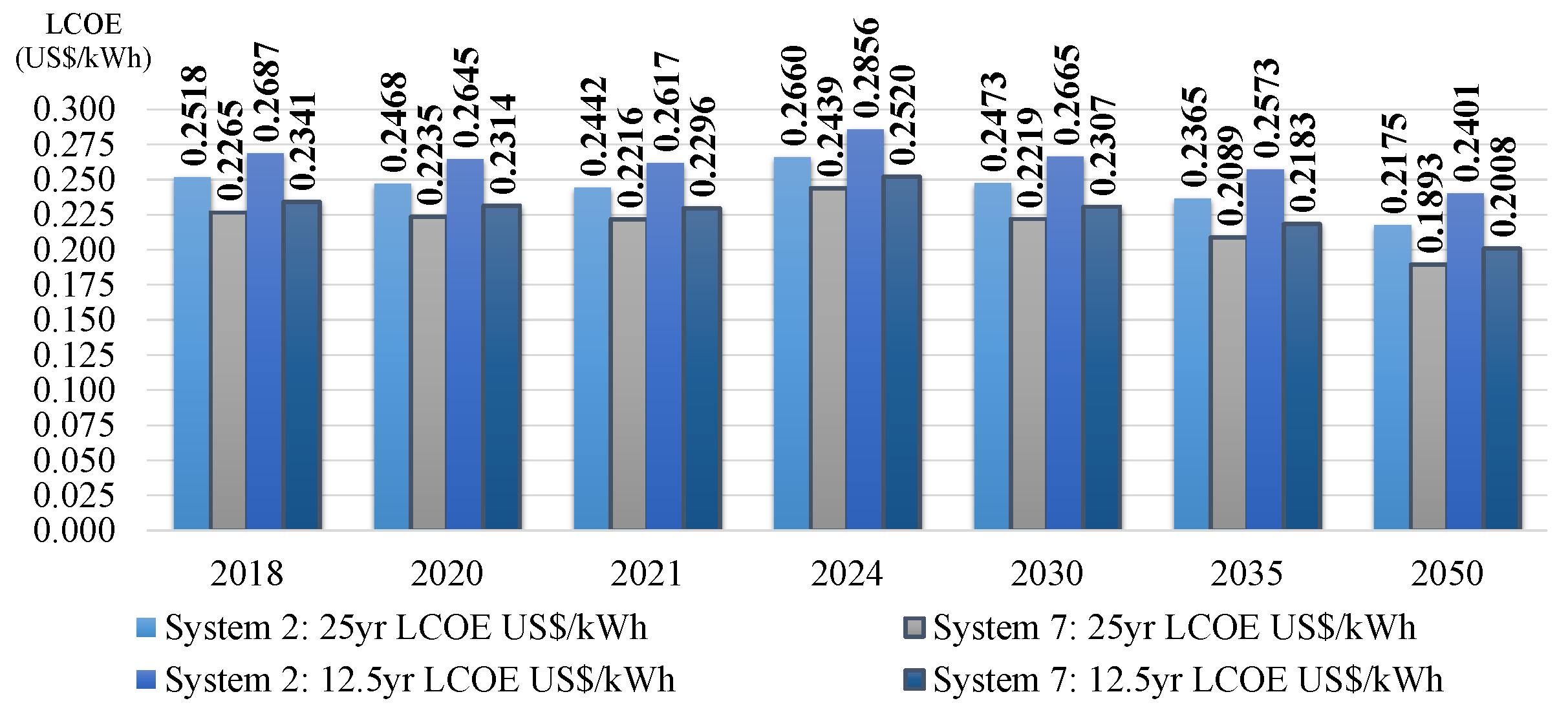

| Intended Nationally Determined Contributions (INDCs) | Paris Agreement | ||||||
|---|---|---|---|---|---|---|---|
| Number of parties that have submitted an INDC: | 189 | Summary of the INDCs | Share of 2012 Greenhouse Gases (GHG) | Signature | Ratification | Entry into Force | |
| Share of global emissions covered by INDCs: | 99.10% | Acceptance (A) | |||||
| No. | Country | Date | |||||
| 1 | China | 30 June 2015 | A peak in carbon dioxide emissions by 2030, with best efforts to peak earlier. China has also pledged to source 20% of its energy from low-carbon sources by 2030 and to cut emissions per unit of GDP by 60–65% of 2005 levels by 2030, potentially putting it on course to peak by 2027. | 23.75% | 22 April 2016 | 03 September 2016 | 04 November 2016 |
| 2 | USA | 31 March 2015 | 26–28% domestic reduction in greenhouse gases by 2025 compared to 2005, making its best effort to reach the 28% target. | 12.10% | 22 April 2016 | 03 September 2016 (A) | 04 November 2016 |
| 3 | EU | 06 March 2015 | At least a 40% domestic reduction in greenhouse gases by 2030 compared to 1990 levels. | 8.97% | 22 April 2016 | 05 October 2016 | 04 November 2016 |
| 4 | India | 01 October 2015 | A 33–35% reduction in emissions intensity by 2030, compared to 2005 levels. Also pledges to achieve 40% of cumulative electricity installed capacity from non-fossil fuel based resources by 2030. Will also increase tree cover, creating an additional carbon sink of 2.5 to 3 billion tonnes of CO equivalent by 2030. | 5.73% | 22 April 2016 | 02 October 2016 | 04 November 2016 |
| 5 | Brazil | 28 September 2015 | A 37% reduction in emissions by 2025, compared to 2005 levels, with a further indicative target of a 43% reduction in emissions by 2030. | 5.70% | 22 April 2016 | 21 September 2016 | 04 November 2016 |
| 6 | Russia | 31 March 2015 | 25–30% domestic reduction in greenhouse gases by 2030 compared to 1990 levels. | 5.35% | 22 April 2016 | ||
| 7 | Japan | 17 May 2015 | A 26% reduction in emissions on 2013 levels by 2030. | 2.82% | 22 April 2016 | 08 November 2016 (A) | 08 December 2016 |
| 8 | Canada | 15 May 2015 | A 30% reduction on 2005 greenhouse gas emissions, by 2030. | 1.96% | 22 April 2016 | 05 October 2016 | 04 November 2016 |
| 9 | Congo | 18 August 2015 | A 17% reduction compared to a business-as-usual scenario by 2030. | 1.53% | 22 April 2016 | ||
| 10 | Indonesia | 23 September 2015 | A 29% reduction in emissions by 2030, compared to business as usual. | 1.49% | 22 April 2016 | 31October 2016 | 30 November 2016 |
| 11 | Australia | 11 August 2015 | A 26% to 28% reduction in emissions by 2030 on 2005 levels. | 1.45% | 22 April 2016 | 09 November 2016 | 09 December 2016 |
| 12 | South Korea | 30 June 2015 | A 37% reduction on business-as-usual emissions by 2030. | 1.28% | 22 April 2016 | 03 November 2016 | 03 December 2016 |
| 13 | Mexico | 30 March 2015 | Unconditional 25% reduction in greenhouse gases and short lived climate pollutants from a business-as-usual scenario by 2030, which would rise to 40% subject to the outcome of a global climate deal. For the unconditional pledge, this means peaking net emissions by 2026 and reducing emissions intensity per unit of GDP by around 40% from 2013 to 2030. | 1.27% | 22 April 2016 | 21 September 2016 | 04 November 2016 |
| 14 | Bolivia | 12 October 2015 | Ending illegal deforestation by 2020, and increasing the share of renewable energy to 79% by 2030 from 39% in 2010. | 1.19% | 22 April 2016 | 05 October 2016 | 04 November 2016 |
| 15 | Iran | 21 November 2015 | A 4% cut in emissions by 2030 relative to business as usual. | 1.05% | 22 April 2016 | ||
| 16 | Saudi Arabia | 10 November 2015 | Expects emissions savings of up to 130 million tonnes of CO equivalent in 2030, relative to business as usual. | 1.05% | 03 November 2016 | 03 November 2016 | 03 December 2016 |
| 17 | Myanmar | 28 September 2015 | Increase hydropower capacity to 9.4 gigawatts by 2030, to achieve rural electrification based on at least 30% renewable sources and to increase the forested area to 30% by 2030. | 1.01% | 22 April 2016 | ||
| 27 | Kazakhstan | 28 September 2015 | An unconditional 15% reduction in economy-wide emissions by 2030, compared to 1990 levels. | 0.70% | 02 August 2016 | 6 December 2016 | 05 January 2017 |
| 35 | United Arab Emirates | 22 October 2015 | Increase the share of “clean energy” in the energy mix to 24% by 2021, up from 0.2% in 2014. | 0.39% | 22 April 2016 | 21 September 2016 (A) | 04 November 2016 |
| 134 | Equatorial Guinea | 21 September 2015 | A 20% reduction in greenhouse gas emissions by 2030, compared to 2010 levels, with a longer-term goal to cut emissions 50% by 2050. | 0.01% | 22 April 2016 | ||
| 141 | Niue | 25 November 2015 | Commits to increase the share of renewables in its electricity generation to 38% by 2020, up from 2% in 2014. This will partly be delivered through a 10% reduction in electricity demand. | 0.00% | 28 October 2016 | 28 August 2016 | 27 November 2016 |
| 142 | Micronesia | 24 November 2015 | An unconditional reduction in greenhouse gases by 28% on 2000 levels by 2025 | 0.00% | 22 April 2016 | 15 September 2016 | 04 November 2016 |
| 144 | Cook Islands | 20 November 2015 | An 81% reduction in emissions by 2030 compared to 2006 levels. | 0.00% | 24 June 2016 | 01September 2016 | 04 November 2016 |
| 145 | Saint Lucia | 18 November 2015 | Commits to a 23% reduction in emissions by 2030 compared to a business-as-usual scenario, equating to emissions reductions of 188GgCOe, with an intermediate target of a 16% reduction by 2023. | 0.00% | 22 April 2016 | 22 April 2016 | 04 November 2016 |
| 146 | Saint Vincent and the Grenadines | 18 November 2015 | Unconditional 22% reduction in emissions by 2025, compared to a business-as-usual scenario. | 0.00% | 22 April 2016 | 29 June 2016 | 04 November 2016 |
| 148 | Fiji | 05 November 2015 | An unconditional 10% emissions cut by 2030, compared to business-as-usual levels. Also targets 100% renewable electricity by 2030. | 0.00% | 22 April 2016 | 22 April 2016 | 04 November 2016 |
| 149 | Antigua and Barbuda | 19 October 2015 | By 2030 reaching 50 megawatts of renewable power capacity. | 0.00% | 22 April 2016 | 21 September 2016 | 04 November 2016 |
| 151 | Samoa | 01 October 2015 | Commits to generating 100% of its electricity from renewable energy by 2025. | 0.00% | 22 April 2016 | 22 April 2016 | |
| 154 | Barbados | 29 September 2015 | A 44% economy-wide emissions cut in 2030, compared to business as usual. Its interim goal of 37% in 2025 is equivalent to a 21% cut relative to 2008 levels. | 0.00% | 22 April 2016 | 22 April 2016 | 04 November 2016 |
| 155 | Cabo Verde | 29 September 2015 | Increasing renewable energy grid penetration, increasing energy efficiency and reforestation programmes. | 0.00% | 22 April 2016 | ||
| 156 | Dominica | 29 September 2015 | An 18% emissions cut by 2020, compared to 2014 levels, with cuts of 39% by 2025 and 45% by 2030 against the same baseline. | 0.00% | 22 April 2016 | 21 September 2016 | 04 November 2016 |
| 157 | Vanuatu | 29 September 2015 | Moving to 65% renewable energy use by 2020 and nearly 100% renewable electricity by 2030, reducing energy emissions by 30% in 2030 compared to business as usual. | 0.00% | 22 April 2016 | 21 September 2016 | 04 November 2016 |
| 158 | Maldives | 28 September 2015 | An unconditional 10% reduction in energy sector emissions by 2030, compared to business as usual. | 0.00% | 22 April 2016 | 22 April 2016 | 04 November 2016 |
| 159 | Kiribati | 26 September 2015 | A conditional 13.7% by 2025 and 12.8% by 2030 reduction, compared to business as usual levels. | 0.00% | 22 April 2016 | 21 September 2016 | 04 November 2016 |
| 165 | Marshall Islands | 21 July 2015 | A 32% reduction in emissions below 2010 levels by 2025, with a further indicative target to reduce emissions by 45% below 2010 levels by 2030, with a view to achieving net zero GHG emissions by 2050, or earlier if possible. | 0.00% | 22 April 2016 | 22 April 2016 | 04 November 2016 |
| No. | Subject | Scenario | 2018 | 2020 | 2021 | 2024 | 2030 | 2035 | 2050 |
|---|---|---|---|---|---|---|---|---|---|
| 1 | Electricity generation with renewable energy sources (%) | High | 25.0% | 30.0% | 30.0% | 35.0% | 38.0% | 40.7% | 50.0% |
| Base | |||||||||
| Low | |||||||||
| 2 | Renewable power generation capacity installed (%) | High | 34.6% | 35.4% | 35.8% | 37.1% | 39.7% | 42.1% | 50.0% |
| Base | |||||||||
| Low | |||||||||
| 3 | Reduction of the CO emission factor respect to 2000 (0.604 tCOeq/MWhel) | High | −30.0% | −50.0% | |||||
| Base | |||||||||
| Low |
| Scenario | |||
|---|---|---|---|
| Low | Base | High | |
| Electricity consumption (%) | 4.7 | 3.8 | 3.3 |
| Power demanded (%) | 4.9 | 4.1 | 3.6 |
| Technology Type | PV | Wind | Wind | Wind | Wind | Wind | Wind | Wind |
|---|---|---|---|---|---|---|---|---|
| Company | Generic | GoldWind | Wind to Energy | Sany | EWT | EWT | EWT | Enercon |
| Power curve type | III B | III A | S | III B | III B | III B | I A | |
| Capacity | 333.33 kW | 2.5 MW | 3 MW | 2 MW | 250 kW | 500 kW | 900 kW | 7.5 MW |
| Model | GW121 | W2E 132 | SE11520 | DW 54/250 | DW 54/500 | DW 54/900 | E-126 135 | |
| Place to install | On-shore | On-shore | Off-shore | On-shore | On-shore | On-shore | On-shore | Off-shore |
| System 1 | √ | √ | ||||||
| System 2 | √ | √ | √ | |||||
| System 3 | √ | √ | √ | |||||
| System 4 | √ | √ | √ | |||||
| System 5 | √ | √ | √ | |||||
| System 6 | √ | |||||||
| System 7 | √ | √ | ||||||
| System 8 | √ | |||||||
| System 9 | √ | √ | ||||||
| System 10 | √ | √ | ||||||
| System 11 | √ | √ | ||||||
| System 12 | √ | |||||||
| All systems include: | W Diesel | M Diesel | GE Diesel | Turbogas | EnerStore | EnerSection | ||
| Diesel | 50 kWh | Converter | ||||||
| *Only for years 2021, 2024, 2030, 2035 and 2050 | √ | √ | √ | * | √ | √ | ||
| Concept | Unit | Diesel | Wind | PV | Flow Batteries | ||
|---|---|---|---|---|---|---|---|
| Current | New | On-Shore | Off-Shore | (Bulk Storage) | |||
| Capital Cost | $/kW | 0 | 620 | 1600 | 4500 | 1346 | 484 |
| $/kWh | 238 | ||||||
| Remplacement Cost | $/kW | 620 | 1600 | 4500 | 1346 | ||
| O&M | $/kWh-year | 0.025 | 0.0005 | ||||
| $/h | 0.0042 | ||||||
| $/kW | 19 | 4.50 | |||||
| Diesel price | $/L | 1 | |||||
| Lifetime | year | 25 | |||||
| Discount Rate | % | 10 | |||||
| Inflation Rate | % | 3 | |||||
| Real Discount Rate | % | 6.8 | |||||
| Diesel start cost | $/year | 1241 | |||||
| Currency | US $ | 2016 constant | |||||
| Operating Reserve | % | 6 | |||||
| Random Variability of electric load | % | 0 | |||||
| No. | Subject | Scenario | 2018 | 2020 | 2021 | 2024 | 2030 | 2035 | 2050 |
|---|---|---|---|---|---|---|---|---|---|
| 1 | Electricity consumed (GWh/year) | High | 313.3 | 343.4 | 359.6 | 412.7 | 543.7 | 684.0 | 1362.2 |
| Base | 305.3 | 328.9 | 341.4 | 381.9 | 477.6 | 575.5 | 1007.0 | ||
| Low | 300.9 | 321.1 | 331.7 | 365.6 | 444.2 | 522.5 | 850.4 | ||
| 2 | Maximum power demand (MW) | High | 53.2 | 58.5 | 61.4 | 70.9 | 94.4 | 119.9 | 245.8 |
| Base | 51.6 | 55.9 | 58.2 | 65.6 | 83.5 | 102.1 | 186.6 | ||
| Low | 50.6 | 54.3 | 56.3 | 62.6 | 77.3 | 92.3 | 156.9 | ||
| 3 | Electricity generation with renewable energy sources (GWh/year) | High | 78.3 | 103.0 | 107.9 | 144.3 | 206.5 | 278.3 | 681.1 |
| Base | 76.3 | 98.7 | 102.4 | 133.5 | 181.4 | 234.1 | 503.5 | ||
| Low | 75.2 | 96.3 | 99.5 | 127.9 | 168.7 | 212.6 | 425.2 | ||
| 4 | Renewable power generation capacity installed including 6% of reserve margin (MW) | High | 19.5 | 22.0 | 23.3 | 27.8 | 39.8 | 53.5 | 130.3 |
| Base | 18.9 | 21.0 | 22.1 | 25.8 | 35.2 | 45.5 | 98.9 | ||
| Low | 18.6 | 20.4 | 21.4 | 24.6 | 32.6 | 41.2 | 83.2 | ||
| 5 | Electricity generation with fossil fuel sources (GWh/year) | High | 235.0 | 240.4 | 251.7 | 268.4 | 337.2 | 405.7 | 681.1 |
| Base | 229.0 | 230.3 | 239.0 | 248.3 | 296.2 | 341.4 | 503.5 | ||
| Low | 225.7 | 224.8 | 232.2 | 237.8 | 275.5 | 310.0 | 425.2 | ||
| 6 | Fossil fuel power generation capacity installed including 6% of reserve margin (MW) | High | 36.9 | 40.1 | 41.8 | 47.3 | 60.3 | 73.6 | 130.3 |
| Base | 35.8 | 38.3 | 39.6 | 43.8 | 53.4 | 62.7 | 98.9 | ||
| Low | 35.1 | 37.2 | 38.3 | 41.7 | 49.4 | 56.7 | 83.2 | ||
| 7 | Reduction of the CO emission factor respect to 2000 (0.604 tCO2eq/MWhel) | High | |||||||
| Base | 0.433 | 0.423 | 0.418 | 0.404 | 0.378 | 0.357 | 0.302 | ||
| Low | (−30%) | (−50%) | |||||||
| 8 | Reserve Margin (%) | High | 6% | ||||||
| Base | |||||||||
| Low | |||||||||
| PV (MW) | GW121 Quantity | W2E 132 Quantity | SE11520 Quantity | DW 54/250 Quantity | DW 54/500 Quantity | DW 54/900 Quantity | E-126 135 Quantity | W Diesel (MW) | M Diesel (MW) | GE Diesel (MW) | Turbogas Diesel (MW) | EnerStore 50 kWh Quantity | EnerSection Converter (MW) | |
|---|---|---|---|---|---|---|---|---|---|---|---|---|---|---|
| System 1 | 23.7 | 71 | 16.32 | 14 | 38.5 | 130 | 5130 | 128.25 | ||||||
| System 2 | 11.7 | 35 | 34 | 16.32 | 14 | 38.5 | 130 | 5130 | 128.25 | |||||
| System 3 | 55.7 | 39 | 167 | 16.32 | 14 | 38.5 | 130 | 5130 | 128.25 | |||||
| System 4 | 49.7 | 39 | 149 | 16.32 | 14 | 38.5 | 130 | 5130 | 128.25 | |||||
| System 5 | 45.7 | 39 | 137 | 16.32 | 14 | 38.5 | 130 | 5130 | 128.25 | |||||
| System 6 | 67 | 16.32 | 14 | 38.5 | 130 | 5130 | 128.25 | |||||||
| System 7 | 30.4 | 85 | 16.32 | 14 | 38.5 | 130 | 5130 | 128.25 | ||||||
| System 8 | 53 | 16.32 | 14 | 38.5 | 130 | 5130 | 128.25 | |||||||
| System 9 | 134.4 | 401 | 16.32 | 14 | 38.5 | 130 | 5130 | 128.25 | ||||||
| System 10 | 127.7 | 383 | 16.32 | 14 | 38.5 | 130 | 5130 | 128.25 | ||||||
| System 11 | 116.7 | 350 | 16.32 | 14 | 38.5 | 130 | 5130 | 128.25 | ||||||
| System 12 | 527.0 | 16.32 | 14 | 38.5 | 130 | 5130 | 128.25 |
| Generation Equipment | LCOE (US$/kWh) 25 Years Lifetime Project | LCOE (US$/kWh) 12.5 Years Lifetime Project | Generation Equipment | LCOE (US$/kWh) 25 Years Lifetime Project | LCOE (US$/kWh) 12.5 Years Lifetime Project |
|---|---|---|---|---|---|
| PV | 0.09 | 0.13 | DW 54/900 kW | 0.12 | 0.16 |
| GW121/2.5 MW | 0.06 | 0.08 | E-126 135 7.5 MW | 0.25 | 0.34 |
| W2E 132/3 MW | 0.14 | 0.19 | W Diesel | 0.23 | 0.23 |
| SE11520 2 MW | 0.06 | 0.08 | M Diesel | 0.23 | 0.23 |
| DW 54/250 kW | 0.06 | 0.07 | GE Diesel | 0.23 | 0.23 |
| DW 54/500 kW | 0.08 | 0.11 | Turbogas Diesel | 0.25 | 0.25 |
| Common Results | 25 Years Lifetime | 12.5 Years Lifetime | ||||||||
|---|---|---|---|---|---|---|---|---|---|---|
| Initial Capital Cost (INV) (US$M) | Discounted Present Value (DPV) (US$M) | Internal Return Rate (IRR) (%) | Discounted Payback (year) | LCOE (US$/kWh) | Net Present Cost (NPC) (US$B) | Operation & Maintenance (O&M) (US$M) | LCOE (US$/kWh) | Net Present Cost (NPC) (US$B) | Operation & Maintenance (O&M) (US$M) | |
| System 1 | 439 | 1,113 | 30.1 | 4.0 | 0.1926 | 2.3 | 157 | 0.2042 | 2.4 | 169 |
| System 2 | 738 | 816 | 17.6 | 6.9 | 0.2175 | 2.6 | 157 | 0.2401 | 2.9 | 180 |
| System 3 | 791 | 818 | 16.9 | 7.1 | 0.2173 | 2.6 | 152 | 0.2419 | 2.9 | 177 |
| System 4 | 836 | 711 | 15.3 | 8.0 | 0.2263 | 2.7 | 157 | 0.2525 | 3.0 | 184 |
| System 5 | 908 | 636 | 13.9 | 9.1 | 0.2324 | 2.8 | 157 | 0.2613 | 3.1 | 187 |
| System 6 | 1,028 | 521 | 12.0 | 11.7 | 0.2422 | 2.9 | 157 | 0.2754 | 3.3 | 191 |
| System 7 | 436 | 1,152 | 31.0 | 3.8 | 0.1893 | 2.3 | 154 | 0.2008 | 2.4 | 166 |
| System 8 | 1,912 | −465 | 3.9 | 16.1 | 0.3246 | 3.9 | 166 | 0.3904 | 4.7 | 232 |
| System 9 | 464 | 1,123 | 29.2 | 4.1 | 0.1920 | 2.3 | 154 | 0.2045 | 2.4 | 167 |
| System 10 | 601 | 967 | 22.1 | 5.6 | 0.2049 | 2.4 | 156 | 0.2225 | 2.7 | 173 |
| System 11 | 784 | 769 | 16.5 | 7.3 | 0.2214 | 2.6 | 157 | 0.2457 | 2.9 | 181 |
| System 12 | 832 | 509 | 13.0 | 9.8 | 0.2434 | 2.9 | 175 | 0.2695 | 3.2 | 201 |
| 1901 | 1909 | 1916 | 1931 | 1933 | 1938 | |
| From Tropical Storm to | √ | √ | √ | √ | √ | |
| Hurricane category 2 | √ | |||||
| Hurricane category 3 | √ | |||||
| or higher | ||||||
| 1942 | 1944 | 1955 | 1967 | 1971 | 1974 | |
| From Tropical Storm to | √ | |||||
| Hurricane category 2 | ||||||
| Hurricane category 3 | √ | √ | √ | √ | √ | |
| or higher | √ | |||||
| 1975 | 1988 | 2003 | 2005 | 2007 | 2008 | |
| From Tropical Storm to | √ | √ | √ | √ | ||
| Hurricane category 2 | √ | √ | ||||
| Hurricane category 3 | √ | √ | √ | √ | ||
| or higher | √ | |||||
| 2010 | 2011 | 2012 | 2013 | 2014 | 2015 | |
| From Tropical Storm to | √ | √ | √ | √ | ||
| Hurricane category 2 | ||||||
| Hurricane category 3 | ||||||
| or higher |
| Main Category | Secondary Categories | |||||||
|---|---|---|---|---|---|---|---|---|
| Overall Points and Ranking Obtained | Economical Points and Ranking Obtained | Technical Points and Ranking Obtained | Land-Use Points and Ranking Obtained | |||||
| Points | Rank | Points | Rank | Points | Rank | Points | Rank | |
| System 7 | 1223 | 1 | 787 | 1 | 375 | 2 | 61 | 4 |
| System 1 | 1158 | 2 | 724 | 3 | 364 | 3 | 70 | 2 |
| System 9 | 1100 | 3 | 752 | 2 | 327 | 5 | 21 | 10 |
| System 2 | 954 | 4 | 484 | 6 | 386 | 1 | 84 | 1 |
| System 10 | 916 | 5 | 628 | 4 | 260 | 8 | 28 | 9 |
| System 3 | 803 | 6 | 401 | 7 | 348 | 4 | 54 | 6 |
| System 11 | 789 | 7 | 540 | 5 | 214 | 10 | 35 | 8 |
| System 4 | 680 | 8 | 311 | 9 | 308 | 6 | 61 | 4 |
| System 5 | 599 | 9 | 249 | 10 | 281 | 7 | 69 | 3 |
| System 12 | 457 | 10 | 319 | 8 | 96 | 11 | 42 | 7 |
| System 6 | 414 | 11 | 175 | 11 | 225 | 9 | 14 | 11 |
| System8 | 189 | 12 | 90 | 12 | 92 | 12 | 7 | 12 |
© 2017 by the authors. Licensee MDPI, Basel, Switzerland. This article is an open access article distributed under the terms and conditions of the Creative Commons Attribution (CC BY) license (http://creativecommons.org/licenses/by/4.0/).
Share and Cite
Mendoza-Vizcaino, J.; Sumper, A.; Galceran-Arellano, S. PV, Wind and Storage Integration on Small Islands for the Fulfilment of the 50-50 Renewable Electricity Generation Target. Sustainability 2017, 9, 905. https://doi.org/10.3390/su9060905
Mendoza-Vizcaino J, Sumper A, Galceran-Arellano S. PV, Wind and Storage Integration on Small Islands for the Fulfilment of the 50-50 Renewable Electricity Generation Target. Sustainability. 2017; 9(6):905. https://doi.org/10.3390/su9060905
Chicago/Turabian StyleMendoza-Vizcaino, Javier, Andreas Sumper, and Samuel Galceran-Arellano. 2017. "PV, Wind and Storage Integration on Small Islands for the Fulfilment of the 50-50 Renewable Electricity Generation Target" Sustainability 9, no. 6: 905. https://doi.org/10.3390/su9060905






